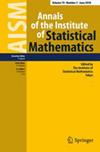一种利用独立样本用插入式方法消除干扰参数的方法
IF 0.6
4区 数学
Q3 STATISTICS & PROBABILITY
Annals of the Institute of Statistical Mathematics
Pub Date : 2025-04-15
DOI:10.1007/s10463-025-00927-y
引用次数: 0
摘要
在干扰参数存在的情况下,结构参数的估计是一个古老而富有挑战性的问题。通常的估计方法是插件似然法,使用相同的数据集来估计结构参数和干扰参数。本文的目的是为使用插件方法估计感兴趣的参数提供一个最优估计函数,当干扰参数的估计量独立于用于估计结构参数的样本时。本文章由计算机程序翻译,如有差异,请以英文原文为准。
A way of eliminating a nuisance parameter with the plug-in method utilizing an independent sample
The estimation of the structural parameter in the presence of a nuisance parameter is an old and challenging problem. The usual estimating method is the plug-in likelihood method, using the same data set for estimating both the structural as well as the nuisance parameters. The aim of this paper is to provide an optimal estimating function for the estimation of the parameter of interest using the plug-in method, when an estimator for the nuisance parameter is available independent of the sample used to estimate the structural parameter.
求助全文
通过发布文献求助,成功后即可免费获取论文全文。
去求助
来源期刊
CiteScore
2.00
自引率
0.00%
发文量
39
审稿时长
6-12 weeks
期刊介绍:
Annals of the Institute of Statistical Mathematics (AISM) aims to provide a forum for open communication among statisticians, and to contribute to the advancement of statistics as a science to enable humans to handle information in order to cope with uncertainties. It publishes high-quality papers that shed new light on the theoretical, computational and/or methodological aspects of statistical science. Emphasis is placed on (a) development of new methodologies motivated by real data, (b) development of unifying theories, and (c) analysis and improvement of existing methodologies and theories.

 求助内容:
求助内容: 应助结果提醒方式:
应助结果提醒方式:


